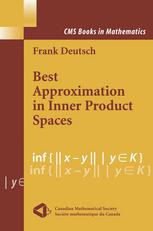

Most ebook files are in PDF format, so you can easily read them using various software such as Foxit Reader or directly on the Google Chrome browser.
Some ebook files are released by publishers in other formats such as .awz, .mobi, .epub, .fb2, etc. You may need to install specific software to read these formats on mobile/PC, such as Calibre.
Please read the tutorial at this link: https://ebookbell.com/faq
We offer FREE conversion to the popular formats you request; however, this may take some time. Therefore, right after payment, please email us, and we will try to provide the service as quickly as possible.
For some exceptional file formats or broken links (if any), please refrain from opening any disputes. Instead, email us first, and we will try to assist within a maximum of 6 hours.
EbookBell Team

4.7
66 reviewsThis book evolved from notes originally developed for a graduate course, "Best Approximation in Normed Linear Spaces," that I began giving at Penn State Uni versity more than 25 years ago. It soon became evident. that many of the students who wanted to take the course (including engineers, computer scientists, and statis ticians, as well as mathematicians) did not have the necessary prerequisites such as a working knowledge of Lp-spaces and some basic functional analysis. (Today such material is typically contained in the first-year graduate course in analysis. ) To accommodate these students, I usually ended up spending nearly half the course on these prerequisites, and the last half was devoted to the "best approximation" part. I did this a few times and determined that it was not satisfactory: Too much time was being spent on the presumed prerequisites. To be able to devote most of the course to "best approximation," I decided to concentrate on the simplest of the normed linear spaces-the inner product spaces-since the theory in inner product spaces can be taught from first principles in much less time, and also since one can give a convincing argument that inner product spaces are the most important of all the normed linear spaces anyway. The success of this approach turned out to be even better than I had originally anticipated: One can develop a fairly complete theory of best approximation in inner product spaces from first principles, and such was my purpose in writing this book.